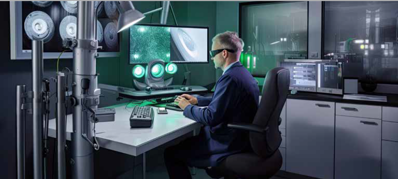Artificial Intelligence, IOL
AI Could Reduce Refractive Surprises
Machine learning for improved IOL power calculation

Dermot McGrath
Published: Monday, July 3, 2023
“ If we look at another study of more than 8,000 eyes, around 50% of the subset of patients with an axial length of 21.00 mm to 21.99 mm were within 0.5 D of target refraction “
 Machine learning and artificial intelligence hold rich potential to help reduce the incidence of refractive surprise after cataract surgery by improving intraocular lens power calculations, according to Dr Lisa Tasch.
Machine learning and artificial intelligence hold rich potential to help reduce the incidence of refractive surprise after cataract surgery by improving intraocular lens power calculations, according to Dr Lisa Tasch.
“Our study clearly showed that a matrix-based regression and machine learning model are superior to conventional IOL power calculation formulas,” she said. “It may not entirely eliminate refractive surprises, but there is a potential benefit to this approach, especially in short eyes.”
Although improvements in biometry technology allied to customized IOL power formulas use has led to greater refractive accuracy, patients with myopia and hyperopia extremes tend to fare worse, Dr Tasch explained.
She noted the 2019 EUREQUO database of 171,930 cataract extractions reported the average spherical equivalent error was about 0.4 D, with around 74% of cases within 0.5 D of target refraction.
“If we look at another study of more than 8,000 eyes, around 50% of the subset of patients with an axial length of 21.00 mm to 21.99 mm were within 0.5 D of target refraction. This was about 30% for very short eyes (20.00 to 20.99 mm), so there is clearly scope for improvement in these cases,” she said.1
With this in mind, Dr Tasch and co-workers developed a machine learning approach to improve lens power calculation using both partial least squares regression (PLSR) and an AI model using a random forest plot. Data included 760 eyes of 760 patients with different lens models, narrowed down to a final data set of 368 eyes: 205 regular eyes with an axial length between 23.01 mm and 25.49 mm, 139 short eyes and 24 long eyes. The data set included preoperative biometry data from the IOLMaster 700 (Carl Zeiss Meditec), IOL type and power, postoperative biometry data, postoperative subjective refraction, and autorefraction.
Predictive parameters in the PLSR model included axial length, white-to-white distance, lens thickness, and anterior chamber depth.
“We used these four significant parameters to train the machine learning algorithm,” Dr Tasch said. “The out-of-bag error development stabilises at about 150 decision trees, which leads us to a mean absolute error of 0.36 D in the out-of-bag sample.”
The PLSR model recorded a lower mean absolute error than the other formulas tested (0.24 D for PLSR, 0.28 D for the AI model, 0.47 D for Haigis, 0.33 D for Barrett, and 0.48 D for Hoffer).
About 65% of the patients in the PLSR model had a mean absolute error of 0.25 D compared to about 50% for the Barrett formula.
Putting the results in context, Dr Tasch said the matrix-based regression and machine learning models are superior to conventional IOL power calculation formulas.
“This is really only the beginning. The next steps are collecting more data, which will further improve the accuracy, and implementing a neuronal network that allows constant learning,” she said.
Dr Tasch gave this presentation at the 2023 ESCRS Winter Meeting in Vilamoura, Portugal.
For citation notes, see page 40.
Lisa Tasch MD is an ophthalmologist at Johannes Kepler University, Linz, Austria. lisa.tasch@kepleruniklinikum.at